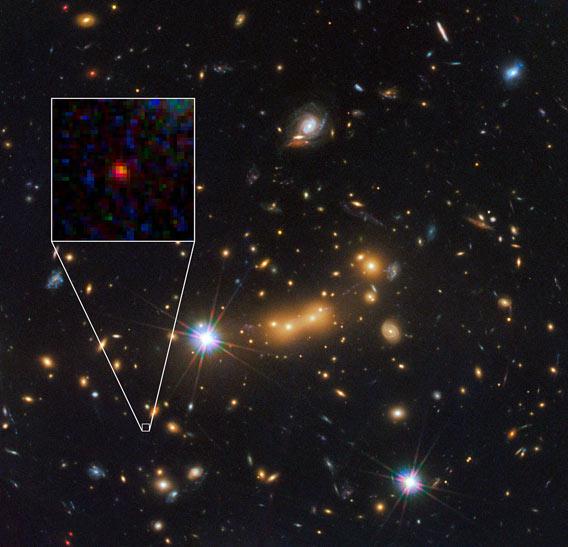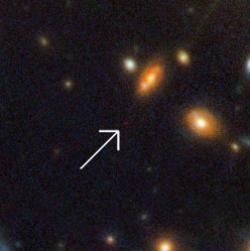Well, this is pretty cool: A weird proto-galaxy spotted by the Hubble Space Telescope may have broken the record for the most distant object ever seen. And—if it pans out—it didn’t just break the record, it smashed it.
Here’s the picture:

Image credit: NASA, ESA, M. Postman and D. Coe (STScI), and the CLASH Team
Yowza. [Click to redshiftenate, or grab the even bigger 1578 x 1520 version.]
The object in question—called MACS0647-JD—is the red blob in the inset. If the calculations hold out, that gloppy looking thing may be at the mind-crushing distance of almost 13.3 billion light years. The light we see from it started on its way when the universe itself was only 420 million years old.
Just typing that made the hair on the back of my neck stand up.
So how does this work? What is this thing, and how did the scientists figure out how far away it is? OK, you’ll have to bear with me. This takes a moment to explain, and it’s a bit of a mind flip, but it’s really cool.
It’s Just a Shift to the Red
You’ve probably heard that the universe is expanding. When astronomers say that, what they mean is that space itself is expanding, carrying everything with it. I know that’s a bit of a brain-twisty thing to think about, but go with it. We have a huge amount of evidence to support this idea, and essentially no professional astronomer seriously doubts it.
What this cosmic expansion means is that galaxies that are far away are moving away from us, and the farther away they are, the faster they’re moving. You’ve probably also experienced the Doppler shift: Sounds change pitch if the source of the sound is moving toward or away from you. When a motorcycle passes you, it makes that familiar “EEEEeeeeeeeooooooowwwwwwww!” sound. The pitch—the frequency of the sound—is higher as it approaches you, then drops when it passes.
A similar thing happens with light. An object moving toward you and emitting light will have the frequency of that light increase. When it moves away from you, the frequency drops. Frequency is related to color; the blue end of the spectrum has a higher frequency than the red end. So we say the light of something moving toward you is blue shifted, and red shifted if it moves away.
When we observe distant galaxies, we see this effect! The farther away a galaxy is, the more redshifted we see its light. In fact, that’s how the universe’s expansion was first discovered. By measuring the amount of redshift we can tell how fast the galaxy is moving away from us and from that determine its distance.
It’s not that easy, but that’s the idea. Usually we use a spectrograph to get the color of the galaxy. This is a device that breaks the light up into thousands of individual colors, allowing a pretty precise determination of the redshift (I’ve done this sort of measurement myself, and it can yield amazingly accurate results). The problem is, something 13.3 billion light years away would be way too faint to see. Let alone measure. But in the case of MACS0647-JD, we had a little help from a few trillion friends.
Let’s Do the Space Warp Today
Take another look at the picture. Almost everything you see in it is a galaxy, a vast collection of hundreds of billions of stars. They’re part of a huge cluster of galaxies called MACS J0647.7 +7015. (I know, that’s awful, but the name’s from the Massive Cluster Survey, with its sky coordinates tacked on.) Now, are you ready for more brain-crushing weirdness? One of Albert Einstein’s big ideas is that that mass literally bends space. The gravity of massive objects warps space, distorting it. Light moves through space and follows that warp, like a car driving along a curvy, hilly road.

NASA, ESA, M. Postman and D. Coe (STScI), and the CLASH Team
The light from the distant galaxy MACS0647-JD had to pass through and around that galaxy cluster to reach us. The gravity of the cluster warps space, which acts like a lens, magnifying and brightening the light from the more distant galaxy! We actually call this effect gravitational lensing, and it’s (har har) massively useful, because it allows us to see distant objects that might otherwise be too faint to see. Such is the case here.
So yay, MACS0647-JD is now bright enough to see! Not only that, but due to the shape of the cluster, the light from the galaxy got split up and multiplied; We actually see three images of it in the big picture above. I’ve inset one here, just so you can see it.
But we’re still not done. There’s one more thing to know.
The Blackness Would Hit Me and the Void Would Be Calling
Even though it appears brighter than it normally would, MACS0647-JD is still way too faint to observe with a spectrograph to get its distance. Instead, astronomers did something clever. They used a series of filters to isolate various colors from the object, ranging from blue out to infrared. They even used observations from the orbiting Spitzer Space Telescope, which is designed to see ever farther out into the infrared. If this galaxy really is 13.3 billion light years away, then it must be an incredibly young object. Young galaxies are loaded with very hot, massive stars that blast out ultraviolet light, and in fact dominate the light emitted from such galaxies. If the galaxy is that far away, the expansion of the universe itself will redshift that UV light by a factor of nearly ten, pushing it well out into the infrared.
Sure enough, when they looked at the images from all the different filters, the galaxy is invisible in all but the infrared ones. That’s a pretty convincing sign it really is that far away. I’ll note the same team that found MACS0647-JD has used this same technique with other, somewhat closer objects, and those have been confirmed using spectroscopy. That lends credence to this new result.
So holy wow. This may really be a galaxy at that forbidding distance. Unfortunately, though, the research paper has not yet been published, so I haven’t read it for myself. Still, the team involved is quite careful and almost certainly was meticulous in their analysis. I have little doubt their results are solid. There is still some chance this may be a foreground object masquerading as something more distant, but it seems unlikely.
So, to be fair, we have to say this is a candidate for the most distant object ever seen. And the funny thing is, it’s not terribly likely we’ll find things much farther away! That’s because the farther away we look, the younger the universe was. And when it was only 420 million years old, it had barely gotten started. We might find things a few tens of millions of light years farther away, maybe even a hundred million or so. But the Universe started with a Big Bang 13.73 billion years ago, so that’s a hard limit to how far away we can see.
And knowing its distance we can figure out how big MACS0647-JD is. It turns out to be pretty dinky as galaxies go: It’s only about 600 light years across and has at most a billion stars. Compare that to our own Milky Way galaxy, living large at 100,000 light years across and containing 200–300 billion stars. MACS0647-JD really is a bit of a dim bulb. It’s most likely still in the act of forming itself into a proper galaxy, so we call it a proto-galaxy. Our own galaxy formed from such modest beginnings as this.
But teeny or not, it’s still amazing. We’re seeing it, quite literally, clear across the universe.
Finding objects like MACS0647-JD is critical to our understanding of the universe. They tell us what things were like when the universe was a mere whippersnapper, something that’s very hard to do otherwise. We can learn how much gas was around back then, what stars were like, how galaxies formed, and even how great the effects of mysterious dark matter and dark energy were, about which very little is known. This new galaxy pushes the limits so hard that everything we learn from it is new.
Plus, it’s just so darn cool! Look at it again, it may just look like a lumpy red blob, but it’s telling us a vast amount about the entire universe we live in. Nothing lives in isolation, no scientific fact sits alone. Everything we see, everywhere, has an impact on what we understand. Even a tiny ball of stars 133 billion trillion kilometers away.